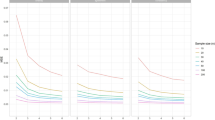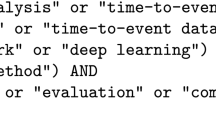Abstract
In multi-center studies, the presence of a cluster effect leads to correlation among outcomes within a center and requires different techniques to handle such correlation. Testing for a cluster effect can serve as a pre-screening step to help guide the researcher towards the appropriate analysis. With time to event data, score tests have been proposed which test for the presence of a center effect on the hazard function. However, sometimes researchers are interested in directly modeling other quantities such as survival probabilities or cumulative incidence at a fixed time. We propose a test for the presence of a center effect acting directly on the quantity of interest using pseudo-value regression, and derive the asymptotic properties of our proposed test statistic. We examine the performance of our proposed test through simulation studies in both survival and competing risks settings. The proposed test may be more powerful than tests based on the hazard function in settings where the center effect is time-varying. We illustrate the test using a multicenter registry study of survival and competing risks outcomes after hematopoietic cell transplantation.


Similar content being viewed by others
References
Andersen PK, Hansen MG, Klein JP (2004) Regression analysis of restricted mean survival time based onpseudo-observations. Lifetime Data Anal 10:335–350. https://doi.org/10.1007/s10985-004-4771-0
Andersen PK, Klein JP, Rosthøj S (2003) Generalised linear models for correlated pseudo-observations, with applications to multi-state models. Biometrika 90(1):15–27. https://doi.org/10.1093/biomet/90.1.15
Andersen PK, Perme MP (2010) Pseudo-observations in survival analysis. Stat Methods Med Res 19(1):71–99. https://doi.org/10.1177/0962280209105020
Commenges D, Andersen PK (1995) Score test of homogeneity for survival data. Lifetime Data Anal 1:145–156
Fine JP, Gray RJ (1999) A proportional hazards model for the subdistribution of a competing risk. J Am Stat Assoc 94(446):496–509
Graw F, Gerds TA, Schumacher M (2009) On pseudo-values for regression analysis in multi-state models. Lifetime Data Anal 15:241–255
Gray RJ (1995) Tests for variation over groups in survival data. J Am Stat Assoc 90:198–203
Jacqmin-Gadda H, Commenges D (1995) Tests of homogeneity for generalized linear models. J Am Stat Assoc 90:1237–1246
Katsahian S, Boudreau C (2011) Estimating and testing for center effects in competing risks. Stat Med 30:1608–1617
Klein JP, Andersen PK (2005) Regression modeling of competing risks data based on pseudovalues of the cumulative incidence function. Biometrics 61(1):223–229. https://doi.org/10.1111/j.0006-341X.2005.031209.x
Klein JP, Logan RB, Harhoff M, Andersen PK (2007) Analyzing survival curves at a fixed point in time. Stat Med 26:4505–4519. https://doi.org/10.1002/sim.2864
Liang KY (1987) A locally most powerful test for homogeneity with many strata. Biometrika 74(2):259–264. https://doi.org/10.1093/biomet/74.2.259
Lin X (1997) Variance component testing in generalised linear models with random effects. Biometrika 84(2):309–326. https://doi.org/10.1093/biomet/84.2.309
Logan BR, Wang T (2014) Chap 10: Pseudo-value regression models. In: Klein JP, van Houwelingen HC, Ibrahim JG, Scheike TH (eds) Handbook of survival analysis. CRC Press, Boca Raton
Logan BR, Zhang MJ, Klein JP (2011) Marginal models for clustered time-to-event data with competing risks using pseudovalues. Biometrics 67:1–7
Satten GA, Datta S (2001) Inverse-probability-of-censoring weighed average. Am Stat 55:207–210
Scheike TH, Zhang M-J, Gerds T (2008) Predicting cumulative incidence probability by direct binomialregression. Biomerika 95:205–220
VanHouwelingen H, Putter H (2008) Dynamic predicting by landmarking as an alternative for multi-state modeling: an application to acute lymphoid leukemia data. Lifetime Data Anal 14:447–463
VanHouwelingen H, Putter H (2015) Comparison of stopped cox regression with direct methods such as pseudo-values and binomial regression. Lifetime Data Anal 21:180–196
Author information
Authors and Affiliations
Corresponding author
Electronic supplementary material
Below is the link to the electronic supplementary material.
Appendix: Asymptotic distribution of the proposed test statistic
Appendix: Asymptotic distribution of the proposed test statistic
Here we assume that the cluster size \(n_k\)’s and the covariates vector \({\varvec{x}}_{kj}\) belong to a bounded set. We also assume standard regularity conditions on the risk set, namely that there exist functions \(r^c(s)\) defined on [0, t] with \(\inf _{s \in [0,t]} r^c(s) >0\) such that
where \(R^c(t)\) denotes the number at risk at time t, \(\{a_n\}\) is a sequence of positive constants.
We derive the asymptotic distribution of the proposed test for the competing risks setting, and note that the survival setting can be obtained as a special case. Before we derive the mean, variance, and distribution of the pseudo-value test under \(H_0\), we first present two Lemmas characterizing regularity conditions on the \(\varphi _{kj}\).
Lemma 1
Under \(H_0\), \({\text {var}}(\varphi _{kj})\) is bounded.
Proof of Lemma 1
The term in (3) is bounded since \(\Delta _{kj}(t)N_{kj}(t)\) is either 0 or 1 and \(1/G(T_{kj})\) is bounded under the regularity conditions on the risk set. The term in (4) can be written as
which is bounded due to the regularity conditions on the risk set.
Finally the term in (5) can be rewritten as
which is bounded in absolute value by \(\Lambda ^c(T_{kj})/G^2(T_{kj})\). Therefore \({\text {var}}(\varphi _{kj})\) is bounded.
The second lemma utilizes Lemma 1 to establish additional regularity conditions used to establish the asymptotic distribution of the proposed test statistic; because the results are straightforward given Lemma 1, it is stated without proof. \(\square \)
Lemma 2
Defining
the following conditions hold:
-
(a)
\(\sum _{k=1}^{\infty }\left\{ {\text {var}}(\partial W_k/\partial \beta _l)/k^2\right\} < \infty \quad \forall \quad l=1,\dots ,p\).
-
(b)
\({\text {E}}\{\partial ^2W_k/\partial \beta _l \partial \beta _m\}\) is bounded \(\forall \quad l,m=1,\dots ,p \quad \) and \(\forall \quad k\).
-
(c)
\(\sum _{k=1}^{\infty }\left\{ {\text {var}}(\partial ^2W_k/\partial \beta _l\beta _m)/k^2\right\} < \infty \quad \forall \quad l,m=1,\dots ,p\).
-
(d)
\(\forall \quad \epsilon >0 \sum _{k=1}^K\int _{\vert z\vert \ge \epsilon }z^2 dF_k \rightarrow 0\) where \(z_k=W_k/I^{1/2}\) with distribution function \(F_k\) (Lindeberg’s condition).
Based on the conditions established in Lemmas 1 and 2, we can prove the following theorem on the asymptotic distribution of the score test statistic under \(H_0\).
Theorem
Under \(H_0\) and the regularity conditions described above,
where \({\widehat{\varvec{\beta }}}\) is a consistent estimator of \(\varvec{\beta }\) under \(H_0\).
Proof
First we show that \(T_{PC}\) is asymptotically equivalent to \(K^{-1/2}W\), where
Note that \({\text {E}}\{\sum _{j=1}^{n_k}(\varphi _{kj}-\mu _{kj}^0)\}=0\). Then by the law of large numbers, since \(n_k\) is bounded and from Lemma 1\({\text {var}}(\varphi _{kj}-\mu _{kj}^0)\) is bounded,
Therefore we have
and the two statistics will have the same limiting distribution. The mean of the limiting distribution of \(K^{-1/2}W\) is 0 because under \(H_0\), \(\varphi _{kj}\) is independent of \(\varphi _{kj'}\), so that
To derive the variance of the limiting distribution first note that since \(\varphi _{kj}\) and \(\varphi _{kj'}\) are independent under \(H_0\) for \(j \ne j'\), \( {\text {E}}[(\varphi _{kj}-\mu _{kj}^0)(\varphi _{kj'}-\mu _{kj'}^0)]=0\) and
for \((l,l') \ne (j,j')\). Then
Proof of asymptotic normality of the test statistic follows closely the derivation in Jacqmin-Gadda and Commenges applied to W, using the regularity conditions in Lemma 2, and so the details are omitted. \(\square \)
Rights and permissions
About this article
Cite this article
Wang, Y., Logan, B.R. Testing for center effects on survival and competing risks outcomes using pseudo-value regression. Lifetime Data Anal 25, 206–228 (2019). https://doi.org/10.1007/s10985-018-9443-6
Received:
Accepted:
Published:
Issue Date:
DOI: https://doi.org/10.1007/s10985-018-9443-6




